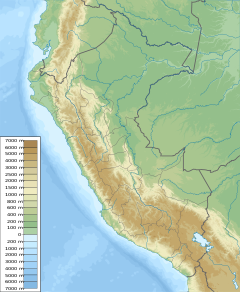| Misti | |
|---|---|
 Misti as viewed from Arequipa | |
| Highest point | |
| Elevation | 5,822 m (19,101 ft) |
| Listing | Ultra |
| Coordinates | 16°17′47″S 71°24′38″W / 16.29639°S 71.41056°W |
| Geography | |
| Country | Peru |
| Region | Arequipa |
| Parent range | Andes |
| Geology | |
| Mountain type | Stratovolcano |
| Volcanic arc/belt | Central Volcanic Zone |
Misti is a dormant volcano located in the Andes mountains in southern Peru, rising above Peru's second-largest city, Arequipa. It is a conical volcano with two nested summit craters, the inner one of which contains a volcanic plug or lava dome with active fumaroles. The summit of the volcano lies on the margin of the outer crater and is 5,822 metres (19,101 ft) above sea level. Snow falls on the summit during the wet season, but does not persist; there are no glaciers. The upper slopes of the volcano are barren, while the lower slopes are covered by bushland.
The volcano developed over four different stages. During each stage, lava flows and lava domes built up a mountain, whose summit then collapsed to form a caldera. The volcano is part of a volcano group with Chachani to the northwest and Pichu Pichu to the southeast, and developed on top of a basement formed by numerous Miocene-Pliocene ignimbrites and volcano-derived debris. Numerous intense explosive eruptions took place during the last 50,000 years and covered the surrounding terrain with tephra. The last two significant eruptions were 2,000 years ago and in 1440–1470 AD; since then, phases of increased fumarolic activity have sometimes been mistaken for eruptions.
Misti is one of the most dangerous volcanoes in the world, as it lies less than 20 kilometres (12 mi) from Arequipa. The city's population exceeds one million people and its northeastern suburbs have expanded on to the slopes of the volcano. The narrow valleys on western and southern flanks are a particular threat, as mudflows and pyroclastic flows can be channelled into the urban area and into important infrastructure, like hydropower plants. Even moderate eruptions can deposit volcanic ash and tephra over most of the city. Until 2005, there was little awareness or monitoring of the volcano. Since then, the Peruvian INGEMMET has set up a volcano observatory in Arequipa, run public awareness campaigns on the dangers of renewed eruptions and published a hazard map. The Inca viewed the volcano as a threat and during the 1440–1470 eruption offered human sacrifices (capacocha) on its summit and that of its neighbours to calm the volcano down; the mummies on Misti are the largest Inca sacrifice known.
